John Piper (artist)
| John Piper | |
|---|---|
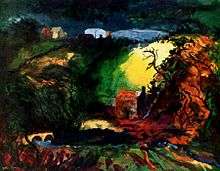 Middle Mill, Pembrokeshire, 1982 | |
| Born |
John Egerton Christmas Piper 13 December 1903 Epsom, Surrey, UK |
| Died |
28 June 1992 (aged 88) Fawley Bottom, Buckinghamshire, UK |
| Nationality | British |
| Education | |
| Known for | Painting, Printmaking |
| Spouse(s) |
|
John Egerton Christmas Piper CH (13 December 1903 – 28 June 1992) was an English painter, printmaker and designer of stained-glass windows and theatre sets. His work often focused on the British landscape, especially churches and monuments, and included tapestry designs, book jackets, screen-prints, photography, fabrics and ceramics. He was educated at Epsom College and trained at the Richmond School of Art, followed by the Royal College of Art in London.[1] He turned from abstraction early in his career, concentrating on a more naturalistic but distinctive approach. He was an official war artist in World War II. Piper collaborated with many others, including the poets John Betjeman and Geoffrey Grigson on the Shell Guides,[2][3] and with the potter Geoffrey Eastop and the artist Ben Nicholson. In his later years he produced many limited-edition prints.
Early life
John Piper was born in Epsom, Surrey, the youngest of three sons to the solicitor Charles Alfred Piper and his wife Mary Ellen Matthews.[4] During Piper's childhood, Epsom was still largely countryside. He went exploring on his bike, and drew and painted pictures of old churches and monuments on the way. He started making guide books complete with pictures and information at a young age. Piper's brothers both served in the First World War and one of them was killed at Ypres in 1915.[4]
.jpg)
John Piper attended Epsom College from 1919. He did not like the college but found refuge in art. When he left Epsom College in 1922, Piper published a book of poetry and wanted to study to become an artist. However, his father disagreed and insisted he join the family law firm, Piper, Smith & Piper in Westminster. Piper worked beside his father in London for three years, took articles but refused the offer of a partnership in the firm. This refusal cost Piper his inheritance but left him free to attend Richmond School of Art. At Richmond, the artist Raymond Coxon prepared him for the entrance exams for the Royal College of Art (RCA), which Piper entered in 1928. While studying at Richmond, Piper met Eileen Holding, a fellow student whom he married in August 1929.[4]
Piper disliked the regime at the RCA and left in December 1929. Piper and Holding lived in Hammersmith and held a joint exhibition of their artworks at Heal's in London in 1931. Piper also wrote art and music reviews for several papers and magazines. One such review, of the artist Edward Wadsworth's work, led to an invitation from Ben Nicholson for Piper to join the Seven and Five Society of modern artists.[4] In 1934 Piper met Myfanwy Evans and early the next year, when Eileen Holding left Piper for another artist, the two moved into an abandoned farmhouse at Fawley Bottom in the Chilterns near Henley-on-Thames. The farmhouse had no mains electricity, no mains water and no telephone connection. Piper and Evans gradually converted the farm's out-buildings to studios for their artworks but it was not until the 1960s that they could afford to modernise the property.[5]
In the following years Piper was involved in a wide variety of projects in several different media. He drew a series on Welsh nonconformist chapels, produced articles on English typography and made arts programmes for the BBC. Through Myfanwy Evans, Piper met John Betjeman in 1937 and Betjeman asked Piper to work on the Shell Guides he was editing. Piper wrote and illustrated the guide to Oxfordshire, focusing on rural churches. In March 1938 Stephen Spender asked Piper to design the sets for his production of Trial of a Judge. Piper's first one-man show in May 1938 included abstract paintings, collage landscapes and more conventional landscapes. His second in March 1940 at the Leicester Galleries, featuring several pictures of derelict ruins, was a sell-out.[4]
World War Two
_(Tate_N05718).jpg)
.jpg)
At the start of World War Two, Piper volunteered to work interpreting aerial reconnaissance photographs for the RAF but was persuaded by Sir Kenneth Clark to work as an official war artist for the War Artists' Advisory Committee, which he did from 1940 to 1944 on short-term contracts.[6] Piper was one of only two artists, the other being Meredith Frampton, commissioned to paint inside of Air Raid Precaution control rooms. Early in 1940 Piper was secretly taken to the ARP underground centre in Bristol where he painted two pictures.[7]
In November 1940 Piper persuaded the WAAC committee that he should be allowed to concentrate upon painting bombed churches. This may have reflected both his pre-war conversion to the Anglican faith as much as his previous interest in depicting derelict architectural ruins. The terms of this commission meant Piper would be visiting bombed cities, and other sites, as soon as possible following an air raid often "the following morning, before the clearing up".[8] Hence he arrived in Coventry the morning after the air raid of 14 November 1940 that resulted in 1000 casualties and the destruction of the medieval cathedral. Piper made drawings of the cathedral and other gutted churches in the city which he subsequently worked up into oil paintings in his studio. Piper's first painting of the bombed cathedral, Interior of Coventry Cathedral, now exhibited at the Herbert Art Gallery, was described by Jeffery Daniels in The Times as "all the more poignant for the exclusion of a human element".
After the bombing raids of 24 November 1940 on Bristol, Piper arrived in the city a day, or possibly two, later. Although Piper only spent a few hours in the city the sketches he made did, by January 1941, result in three oil paintings of ruined churches, St Mary-le-Port, Bristol, The Temple Church and The Church of the Holy Nativity.[8] Piper also painted bombed churches and other buildings in London and Newport Pagnell and also spent a week painting in Bath after the Bath Blitz air raids in April 1942.[5][9]
In 1943, the War Artists' Advisory Committee (WAAC) commissioned Piper to go to Blaenau Ffestiniog, to the disused slate mine where the paintings from the National Gallery had been evacuated for safety during the Blitz. Piper found conditions in the quarry too difficult to work in but did paint some landscapes in the area and would frequently return to Snowdonia after the War.[10][11]
Piper was also commissioned by WAAC to record a series of experiments on bomb shelter designs and land reclamation work. Alongside Vivian Pitchforth, he painted the bombed interior of the House of Commons. In July 1944 WAAC appointed Piper to the full-time artist post vacated by John Platt at the Ministry of War Transport. In this role Piper painted rail and marine transport scenes in Cardiff, Bristol, Southampton and other south-coast locations.[9][12]
Throughout the war Piper also undertook work for the Recording Britain project, initiated by Kenneth Clark, to paint historic sites thought to be at risk from bombing or neglect.[13] [14] He also undertook some private commissions during the war. Viscount Ridley commissioned him to produce a series of watercolours of Blagdon Hall and this led to a commission from the Royal family for a series of watercolours of Windsor Castle and Windsor Great Park, which Piper completed by March 1942.[5] Sir Osbert Sitwell invited Piper to Renishaw Hall to paint the house and illustrate an autobiography he was writing. Piper made the first of many visits to the estate in 1942. The family retain 70 of his pictures and there is a display at the hall.[15] Piper painted a similar series at Knole House for Edward Sackville-West.[4] In 1943, Piper received the first of several poster commissions from Ealing Studios. His draft poster for the film The Bells Go Down featured a view of St Paul's Cathedral seen among monumental ruins.[16]
Later life
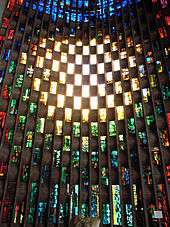
From 1950 Piper began working in stained glass in partnership with Patrick Reyntiens, whom he had met through John Betjeman.[17] Their first completed commission, for the chapel at Oundle School, led to Basil Spence commissioning them to design the stained-glass Baptistry window for the new Coventry Cathedral. They produced an abstract design that occupies the full height of the bowed baptistry, and comprises 195 panes, ranging from white to deep blue.[18] Piper and Reyntiens went on to design large stained-glass windows for the Chapel of Robinson College, Cambridge, and "The Land Is Bright", a large window in the Washington National Cathedral, as well as windows for many smaller churches.[18]
Piper created tapestries for Chichester Cathedral, Hereford Cathedral and Llandaff Cathedral in Cardiff. Piper had previously made working visits to south Wales in both 1936 and 1939 and for several years, between 1943 and 1951, he would also make an annual painting trip to Snowdonia. Throughout the 1960s and 1970s he would regularly spend time painting in Pembrokeshire.[19] He was a theatre set designer, including for the Kenton Theatre in Henley. He designed many of the premiere productions of Benjamin Britten's operas at Glyndebourne Festival Opera, the Royal Opera House, La Fenice and the Aldeburgh Festival, as well as for some of the operas of Alun Hoddinott.
In the 1950s, Piper produced pioneering designs for furnishing fabrics for Arthur Sanderson & Sons Ltd and David Whitehead Ltd, as part of a movement to bring art and design to the masses.[20]
Piper wrote extensively on modern art in books and articles.[21][22][23] With his wife Myfanwy Piper he founded the contemporary art journal Axis. From 1946 until 1954, Piper served as a trustee of the Tate gallery.[1]
After suffering from Alzheimer's Disease for some time, John Piper died at his home at Fawley Bottom, Buckinghamshire, where he had lived for most of his life. His children are the painters Edward Piper (deceased) and Sebastian Piper, and his grandchildren include painter Luke Piper and sculptor Henry Piper.
Piper's auction record, £325,250, was set at Sotheby's on 15 July 2008 for "Forms on Dark Blue", a 3' by 4' oil painting made in 1936.[24]
Exhibitions
The Tate collection holds 180 of Piper's works, including etchings and some earlier abstractions. Major retrospective exhibitions have been held at Tate Britain (1983–84),[25] the Dulwich Picture Gallery,[26] the Imperial War Museum,[27] the River and Rowing Museum,[28][29] Museum of Reading and Dorchester Abbey. In 2012 a major exhibition called John Piper and the Church, curated by Patricia Jordan Evans of Bohun Gallery, examined his relationship with the Church and his contribution to the development of modern art within churches.[30] In 2016, the Pallant House Gallery mounted an exhibition entitled John Piper: The Fabric of Modernism which focused on Piper’s textile designs.[20]
Bibliography
- Oxfordshire, Shell Guide No. 11, 1938, (Faber & Faber),
- British Romantic Artists, 1942, (Collins), published as Volume 34 of Britain in Pictures,
- Buildings and Prospects, 1948, (London: Architechural Press), a collection of published articles,
- Shropshire, A Shell Guide, 1951, with John Betjeman,[31]
- Piper's Places: John Piper in England and Wales, 1983, with Richard Ingrams,(London: Chatto & Windus, The Hogarth Press) (ISBN 0-7011-2550-0).
Stained glass
Examples of stained glass designed by John Piper:
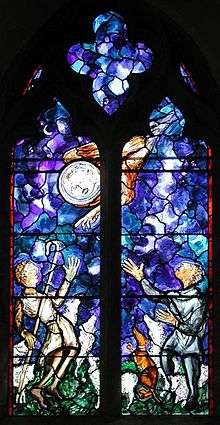 The Church of St Mary The Virgin, Lamberhurst, Kent
The Church of St Mary The Virgin, Lamberhurst, Kent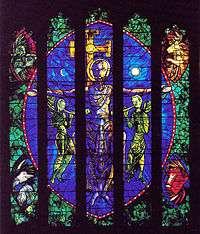 East window in the Chapel of St John, Lichfield, Staffordshire
East window in the Chapel of St John, Lichfield, Staffordshire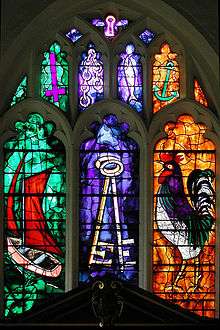 East window in St Peter's Church, Babraham, Cambridgeshire
East window in St Peter's Church, Babraham, Cambridgeshire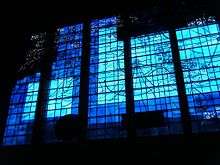 St Andrew's Church, Wolverhampton, West Midlands
St Andrew's Church, Wolverhampton, West Midlands
References
- 1 2 Mary Chamot, Dennis Farr, Martin Butlin (1964–65). The Modern British Paintings, Drawings and Sculpture, volume II. London: Oldbourne Press; cited at Artist biography: John PIPER b. 1903. Tate. Accessed February 2014.
- ↑ Archaeology: A reference handbook by Alan Edwin Day, p. 254. ISBN 978-0-208-01672-0.
- ↑ Guide to Reference Books by Eugene P. Sheehy, p. 636. ISBN 978-0-8389-0390-2.
- 1 2 3 4 5 6 H. C. G. Matthew & Brian Harrison (eds) (2004). Oxford Dictionary of National Biography Vol. 44 (Phelps-Poston). Oxford University Press. ISBN 0-19-861394-6.
- 1 2 3 David Fraser Jenkins & Hugh Fowler-Wright (2016). The Art of John Piper. Unicorn & The Portland Gallery. ISBN 9781910787052.
- ↑ Juliet Gardiner (2004). Wartime, Britain 1939-1945. Review/Headline Book Publishing. ISBN 0 7553 1028 4.
- ↑ Art from the Second World War. Imperial War Museum. 2007. ISBN 978-1-904897-66-8.
- 1 2 Matthew Gale (1996). "Catelogue entry: St.Mary le Port, Bristol (1940)". Tate. Retrieved 13 July 2015.
- 1 2 Brain Foss (2007). War Paint: Art, War, State and Identity in Britain, 1939-1945. Yale University Press. ISBN 978-0-300-10890-3.
- ↑ Melissa Munro (27 April 2012). "John Piper: A Journey Through Snowdonia". National Museum Wales. Retrieved 3 November 2015.
- ↑ "John Piper". Oriel Glyn-y-Weddw. 2014. Retrieved 27 October 2015.
- ↑ Imperial War Museum. "War artists archive: John Piper". Imperial War Museum. Retrieved 14 June 2015.
- ↑ Alan Sykes (27 March 2013). "Exhibition at Durham shows art commissioned during the dark days of the Blitz". The Guardian. Retrieved 15 September 2015.
- ↑ Richard Humphreys (2001). Tate Britain Companion to British Art. Tate Publishing. ISBN 185 437 3730.
- ↑ Frances Spalding (20 May 2010). "Ways With Words 2010: John Piper: a sombre yet fiery genius". The Telegraph. Retrieved 1 January 2013.
- ↑ Art from the Second World War (2015 edition). Imperial War Museum. 2015. ISBN 978-1-904897-66-8.
- ↑ Christ between St Peter & St Paul. Victoria and Albert Museum. Accessed February 2014.
- 1 2 Judith Neiswander & Caroline Swish (2005). Stained & Art Glass, A Unique History of Glass Design and Making. The Intelligent Layman Publishers Ltd. ISBN 094779865X.
- ↑ Peter W. Jones & Isabel Hitchman (2015). Post War to Post Modern: A Dictionary of Artists in Wales. Gomer Press. ISBN 978 184851 8766.
- 1 2 "John Piper: the Fabric of Modernism". Pallant House Gallery. 2016. Retrieved 9 May 2016.
- ↑ "The Listener articles 1933–"Young English Painters: Contemporary English Drawing"
- ↑ "Lost, A Valuable Object" an essay in Myfanwy Piper's anthology "The Painter's Object", 1937.
- ↑ "England's Early Sculptors", Architectural Review, 1937.
- ↑ 20th Century British Art sale, Sotheby's.
- ↑ Jenkins, David Fraser, John Piper, London: Tate Gallery Publications, 1983 (ISBN 0-905005-94-5).
- ↑ Jenkins, David Fraser, & Frances Spalding, John Piper in the 1930s – Abstraction on the Beach, Merrell Publishers, 2003 (ISBN 1-85894-223-3).
- ↑ Jenkins, David Fraser, John Piper – The Forties, Philip Wilson Publishers, 2000 (ISBN 0-85667-529-6).
- ↑ John Piper – Master of Diversity at the Wayback Machine (archived 22 April 2001) exhibition, River and Rowing Museum, 2000.
- ↑ Bowen, Jane (curator), John Piper Centenary: Crossing Boundaries, 2002 (ISBN 0-9535571-4-6).
- ↑ "John Piper and the Church", Dorchester Abbey, Oxfordshire, 21 April - 10 June 2012. A celebration of HM The Queen’s Diamond Jubilee by The Friends of Dorchester Abbey.
- ↑ William S. Peterson. John Betjeman: A Bibliography. Oxford University Press.
Further reading
- Bowen, Jane (curator), John Piper Centenary: Crossing Boundaries (2002) (ISBN 0-9535571-4-6).
- Davis, Howard, A Great Job of Work For All Time. John Piper – Unknown Mosaicist, Andamento No. 3 (2009 [British Association for Modern Mosaic]) OCLC 226080837
- Heathcote, David, A Shell Eye on England: The Shell County Guides 1934–1984 (Faringdon: Libri Publishing, 2010) (ISBN 978-1- 907471-07-0)
- Jenkins, David Fraser, & John Piper, A Painter's Camera (London: Tate Gallery Publications, 1987) (ISBN 0-946590-81-8)
- Jenkins, David Fraser, John Piper – The Robert and Rena Lewin Gift to the Ashmolean Museum (Oxford: Ashmolean Museum, 1992) (ISBN 1-85444-025-X).
- Levinson, Orde, Quality and Experiment: The Prints of John Piper — A Catalogue Raisonné 1932–91 (London: Lund Humphries Publishers, 1996) (ISBN 0-85331-690-2).
- Spalding, Frances, John Piper, Myfanwy Piper: Lives in Art (Oxford University Press, 2009) (ISBN 978-0-19-956761-4).
- Powers, Alan, et al., Piper in Print (Artist's Choice Edition, 2010) (ISBN 978-0-9558343-2-5).
- West, Anthony, John Piper (Secker & Warburg, 1979) (ISBN 0-436-56591-9).
- Woods, S. John, John Piper Paintings Drawings & Theatre Designs 1932–1954 (New York: Curt Valentin, 1955)
- Wortley, Laura, John Piper – Master of Diversity (Henley-on-Thames: River and Rowing Museum, 2000) (ISBN 0-9535571-1-1) OCLC 55970238
- John Piper (1983, Tate Gallery)
- John Piper, "Book illustration and the painter-artist", in Penrose Annual; 43 (1949), p. 52–54
- John Piper and the Church exhibition catalogue, edited by Patricia Jordan Evans and Joanna Cartwright (2012)
External links
- Paintings by John Piper at the Art UK site